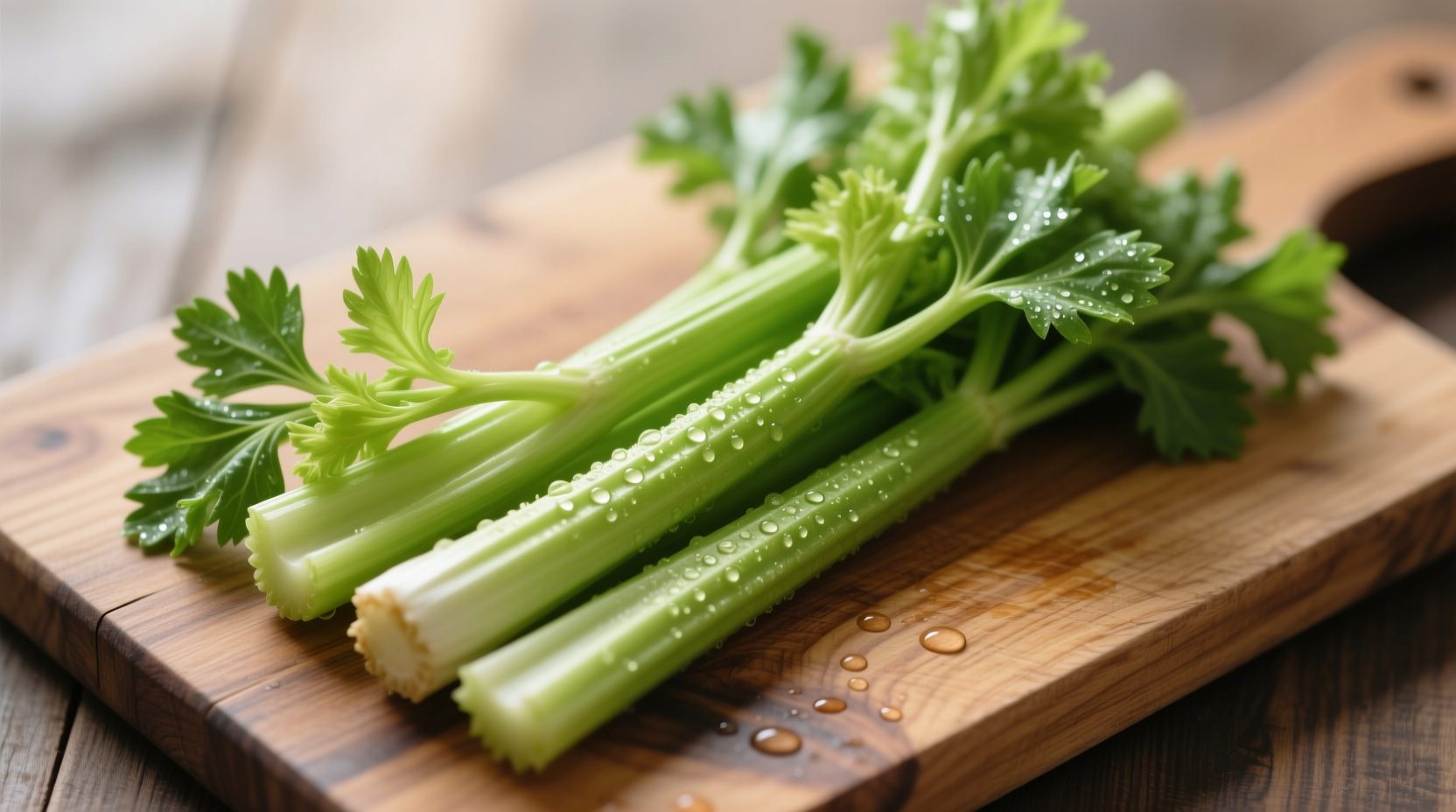Celery (Apium graveolens) is a nutrient-dense vegetable with crisp stalks, aromatic leaves, and versatile culinary applications. One cup (101g) of chopped celery provides 16 calories, 1.6g fiber, 30% of your daily vitamin K needs, and significant potassium and vitamin C. Its natural sodium content (80mg per cup) makes it ideal for hydration-focused diets, while the compound apigenin shows promising anti-inflammatory properties in peer-reviewed research.
When you reach for that bundle of crisp green stalks, you're accessing one of history's most versatile vegetables. Unlike trendy superfoods that come and go, celery has maintained its culinary relevance for millennia through its unique flavor profile and remarkable adaptability. Professional chefs consistently rank celery among the "holy trinity" of foundational aromatics alongside onions and carrots - a testament to its irreplaceable role in building flavor bases across global cuisines.
Understanding Celery's Botanical Identity
Celery belongs to the Apiaceae family, sharing genetic ties with parsley, carrots, and fennel. While most Americans recognize only the familiar Pascal celery with its thick green stalks, three distinct varieties serve different culinary purposes:
| Variety | Characteristics | Best Culinary Uses |
|---|---|---|
| Pascal (Green) Celery | Thick stalks, vibrant green, pronounced flavor | Soups, stews, mirepoix, raw applications |
| Celeriac (Celery Root) | Knobby brown root, earthy flavor | Purees, roasts, salads, gratins |
| Golden (Blanched) Celery | Pale yellow, delicate flavor, tender texture | Salads, garnishes, delicate sauces |
The Science-Backed Health Profile
Nutrition research from the USDA FoodData Central confirms celery's impressive nutritional profile. Beyond its well-known hydration properties (95% water content), celery delivers meaningful amounts of essential nutrients often overlooked:
- Vitamin K: Critical for blood clotting and bone metabolism (30% DV per cup)
- Potassium: Supports healthy blood pressure regulation (9% DV)
- Apigenin: A flavonoid showing anti-inflammatory effects in studies published in Nutrition and Cancer
A 2022 review in Antioxidants highlighted celery's phytonutrient profile, noting that "the combined effect of luteolin, apigenin, and other phenolic compounds contributes to celery's potential protective effects against oxidative stress." While not a miracle cure, incorporating celery into a balanced diet provides measurable nutritional benefits without significant caloric cost.

Mastering Celery Selection and Storage
Professional chefs evaluate celery using three critical indicators that home cooks can easily apply:
- Stalk Integrity: Snap a small piece - it should break crisply with audible resistance
- Leaf Condition: Vibrant green leaves indicate recent harvest (avoid yellowing)
- Root End: Moist but not slimy or dried out
Proper storage dramatically extends celery's shelf life. Research from the University of California Agriculture Department demonstrates that wrapping celery tightly in aluminum foil before refrigeration maintains crispness for up to three weeks - significantly longer than standard plastic bag storage. For long-term preservation, blanch stalks for 3 minutes before freezing in airtight containers.
Culinary Applications Beyond the Salad Bowl
Celery's flavor compounds activate differently based on preparation method. Understanding these transformations unlocks its full potential:
Raw Applications
When served raw, celery delivers a refreshing crunch with subtle herbal notes. The stringy fibers contain concentrated flavor compounds - remove them with a vegetable peeler for delicate preparations. Try these professional techniques:
- Soak cut pieces in ice water for 30 minutes to maximize crispness
- Combine with apple and walnuts for a refreshing salad
- Use as edible scoops for tuna or chicken salad
Cooked Transformations
Heat transforms celery's flavor profile dramatically. When sautéed slowly in fat (the French call this "sweating"), its natural sugars caramelize while harsher compounds mellow. This forms the flavor foundation for countless dishes:
- Mirepoix: Equal parts celery, onions, and carrots (the French base for soups and sauces)
- Stocks and Broths: Celery leaves add depth that stalks alone cannot provide
- Roasted: Toss with olive oil and herbs for sweet, concentrated flavor
Avoiding Common Culinary Mistakes
Even experienced cooks sometimes misuse celery. Understanding these context boundaries prevents disappointing results:
- Don't overcook in soups: Add celery during the last 20 minutes to maintain texture
- Avoid high-heat searing: Celery burns easily - use medium-low heat for sautéing
- Don't discard leaves: They contain more flavor and nutrients than stalks
- Balance strong flavors: Pair with acidic components (lemon, vinegar) to cut bitterness
Global Culinary Traditions Featuring Celery
Celery's journey from medicinal herb to kitchen staple spans continents and centuries. Historical records show Egyptian tomb paintings depicting celery as early as 850 BCE, while medieval Europeans primarily used it for medicinal purposes. The vegetable gained culinary prominence in 17th century Italy, where chefs developed the mirepoix technique that would later influence French cuisine.
Today, culinary traditions worldwide showcase celery's versatility:
- Chinese cuisine: Stir-fried with beef or pork for texture contrast
- Middle Eastern cooking: Finely chopped in tabbouleh alongside parsley
- Cajun/Creole: Essential component of the "holy trinity" (celery, bell pepper, onion)
- Scandinavian traditions: Preserved through lacto-fermentation
Practical Integration into Daily Cooking
You don't need elaborate recipes to benefit from celery's culinary properties. These simple techniques make immediate impact:
- Add whole stalks to stock pots for subtle flavor enhancement
- Freeze celery leaves in olive oil for instant flavor cubes
- Blend celery with cucumber for refreshing summer soup
- Use celery salt (homemade: 2 parts ground celery seeds to 1 part salt) as seasoning
Remember that celery's true value lies in its ability to enhance other ingredients rather than dominate dishes. When properly used, it creates harmony in flavor profiles that elevates entire recipes without calling attention to itself.











 浙公网安备
33010002000092号
浙公网安备
33010002000092号 浙B2-20120091-4
浙B2-20120091-4